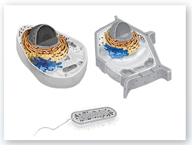Organelles That Build Proteins
 What organelles help make and transport proteins?
What organelles help make and transport proteins?
Life is a dynamic process, and living things are always working, building new molecules all the time, especially proteins, which catalyze chemical reactions and make up important structures in the cell. Because proteins carry out so many of the essential functions of living things, a big part of the cell is devoted to their production and distribution. Proteins are synthesized on ribosomes, sometimes in association with the rough endoplasmic reticulum in eukaryotes. The process of making proteins is summarized in Figure 7–11.

Ribosomes One of the most important jobs carried out in the cellular “factory” is making proteins.  Proteins are assembled on ribosomes. Ribosomes are small particles of RNA and protein found throughout the cytoplasm in all cells. Ribosomes produce proteins by following coded instructions that come from DNA. Each ribosome, in its own way, is like a small machine in a factory, turning out proteins on orders that come from its DNA “boss.” Cells that are especially active in protein synthesis often contain large numbers of ribosomes.
Proteins are assembled on ribosomes. Ribosomes are small particles of RNA and protein found throughout the cytoplasm in all cells. Ribosomes produce proteins by following coded instructions that come from DNA. Each ribosome, in its own way, is like a small machine in a factory, turning out proteins on orders that come from its DNA “boss.” Cells that are especially active in protein synthesis often contain large numbers of ribosomes.
Endoplasmic Reticulum Eukaryotic cells contain an internal membrane system known as the endoplasmic reticulum (en doh PLAZ mik rih TIK yuh lum), or ER. The endoplasmic reticulum is where lipid components of the cell membrane are assembled, along with proteins and other materials that are exported from the cell.
The portion of the ER involved in the synthesis of proteins is called rough endoplasmic reticulum, or rough ER. It is given this name because of the ribosomes found on its surface. Newly made proteins leave these ribosomes and are inserted into the rough ER, where they may be chemically modified.
VISUAL SUMMARY
MAKING PROTEINS

FIGURE 7–11 Together, ribosomes, the endoplasmic reticulum, and the Golgi apparatus synthesize, modify, package, and ship proteins. Infer What can you infer about a cell that is packed with more than the typical number of ribosomes?
Table of Contents
- Formulas and Equations
- Applying Formulas and Equations
- Mean, Median, and Mode
- Estimation
- Using Measurements in Calculations
- Effects of Measurement Errors
- Accuracy
- Precision
- Comparing Accuracy and Precision
- Significant Figures
- Calculating With Significant Figures
- Scientific Notation
- Calculating With Scientific Notation
- Dimensional Analysis
- Applying Dimensional Analysis




